| # |
predsjednik |
početak mandata |
kraj mandata |
stranka |
Potpredsjednik |
br. mandata |
|---|
| 1. |
 |
|
George Washington |
30. travnja 1789. |
4. ožujka 1797. |
nestranački |
|
John Adams |
1 |
| 2 |
| 2. |
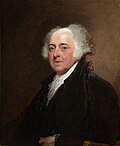 |
|
John Adams |
4. ožujka 1797. |
4. ožujka 1801. |
Federalistička |
|
Thomas Jefferson |
3 |
| 3. |
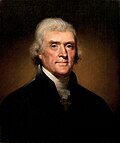 |
|
Thomas Jefferson |
4. ožujka 1801. |
4. ožujka 1809. |
Demokratsko-
republikanska |
|
Aaron Burr |
4 |
|
George Clinton |
5 |
| 4. |
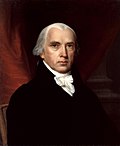 |
|
James Madison |
4. ožujka 1809. |
4. ožujka 1817. |
Demokratsko-
republikanska |
|
George Clinton[n 1]
4. ožujka 1809. – 20. travnja 1812. |
6 |
upražnjeno[n 2]
20. travnja 1812. – 4. ožujka 1813. |
|
Elbridge Gerry[n 1]
4. ožujka 1813. – 23. studenoga 1814. |
7 |
upražnjeno[n 2]
23. studenoga 1814. – 4. ožujka 1817. |
| 5. |
 |
|
James Monroe |
4. ožujka 1817. |
4. ožujka 1825. |
Demokratsko-
republikanska |
|
Daniel D. Tompkins |
8 |
| 9 |
| 6. |
 |
|
John Quincy Adams |
4. ožujka 1825. |
4. ožujka 1829. |
Demokratsko-
republikanska
Nacionalna
republikanska |
|
John C. Calhoun |
10 |
| 7. |
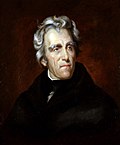 |
|
Andrew Jackson |
4. ožujka 1829. |
4. ožujka 1837. |
Demokratska |
|
John C. Calhoun [n 3]
4. ožujka 1829. – 28. prosinca 1832. |
11 |
upražnjeno[n 2]
28. prosinca 1832. – 4. ožujka 1833. |
|
Martin Van Buren |
12 |
| 8. |
 |
|
Martin Van Buren |
4. ožujka 1837. |
4. ožujka 1841. |
Demokratska |
|
Richard Mentor Johnson |
13 |
| 9. |
 |
|
William Henry Harrison |
4. ožujka 1841. |
4. travnja 1841.
[n 1] |
Vigovska |
|
John Tyler |
14 |
10.
[n 4] |
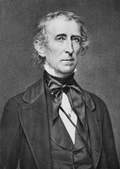 |
|
John Tyler |
4. travnja 1841. |
4. ožujka 1845. |
Vigovska
4. travnja 1841. – 13. rujna 1841. |
upražnjeno[n 2] |
| |
nestranački[n 5]
13. rujna 1841. – 4. ožujka 1845. |
| 11. |
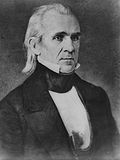 |
|
James Knox Polk |
4. ožujka 1845. |
4. ožujka 1849. |
Demokratska |
|
George M. Dallas |
15 |
| 12. |
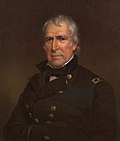 |
|
Zachary Taylor |
4. ožujka 1849. |
9. srpnja 1850.
[n 1] |
Vigovska |
|
Millard Fillmore |
16 |
| 13. |
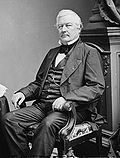 |
|
Millard Fillmore |
9. srpnja 1850. |
4. ožujka 1853. |
Vigovska |
upražnjeno[n 2] |
| 14. |
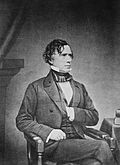 |
|
Franklin Pierce |
4. ožujka 1853. |
4. ožujka 1857. |
Demokratska |
|
William R. King[n 1]
4. ožujka 1853. – 18. travnja 1853. |
17 |
upražnjeno[n 2]
18. travnja 1853. – 4. ožujka 1857. |
| 15. |
 |
|
James Buchanan |
4. ožujka 1857. |
4. ožujka 1861. |
Demokratska |
|
John C. Breckinridge |
18 |
| 16. |
 |
|
Abraham Lincoln |
4. ožujka 1861. |
15. travnja 1865.
[n 6] |
Republikanska
Nacionalna unija
[n 7] |
|
Hannibal Hamlin |
19 |
|
Andrew Johnson |
20 |
| 17. |
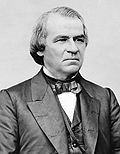 |
|
Andrew Johnson |
15. travnja 1865. |
4. ožujka 1869. |
Demokratska
Nacionalna unija
[n 7] |
upražnjeno
[n 2] |
| |
Nacionalna unija
[n 7]
nestranački[n 8] |
| 18. |
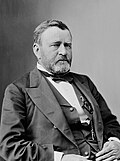 |
|
Ulysses S. Grant |
4. ožujka 1869. |
4. ožujka 1877. |
Republikanska |
|
Schuyler Colfax |
21 |
|
Henry Wilson[n 1]
4. ožujka 1873. – 22. studenoga 1875. |
22 |
upražnjeno[n 2]
22. studenoga 1875. – 4. ožujka 1877. |
| 19. |
 |
|
Rutherford B. Hayes |
4. ožujka 1877. |
4. ožujka 1881. |
Republikanska |
|
William A. Wheeler |
23 |
| 20. |
 |
|
James A. Garfield |
4. ožujka 1881. |
19. rujna 1881.
[n 6] |
Republikanska |
|
Chester A. Arthur |
24 |
| 21. |
 |
|
Chester A. Arthur |
19. rujna 1881. |
4. ožujka 1885. |
Republikanska |
upražnjeno[n 2] |
| 22. |
 |
|
Grover Cleveland |
4. ožujka 1885. |
4. ožujka 1889. |
Demokratska |
|
Thomas A. Hendricks[n 1]
4. ožujka 1885. – 25. studenog 1885. |
25 |
upražnjeno[n 2]
25. studenog 1885. – 4. ožujka 1889. |
| 23. |
 |
|
Benjamin Harrison |
4. ožujka 1889. |
4. ožujka 1893. |
Republikanska |
|
Levi P. Morton |
26 |
| 24. |
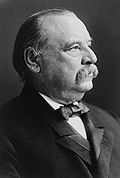 |
|
Grover Cleveland
(drugi mandat) |
4. ožujka 1893. |
4. ožujka 1897. |
Demokratska |
|
Adlai E. Stevenson I |
27 |
| 25. |
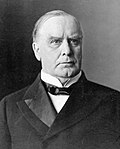 |
|
William McKinley |
4. ožujka 1897. |
14. rujna 1901.
[n 6] |
Republikanska |
|
Garret Hobart[n 1]
4. ožujka 1897. – 21. studenog 1899. |
28 |
upražnjeno[n 2]
21. studenog 1899. – 4. ožujka 1901. |
|
Theodore Roosevelt |
29 |
| 26. |
 |
|
Theodore Roosevelt |
14. rujna 1901. |
4. ožujka 1909. |
Republikanska |
upražnjeno[n 2] |
|
Charles W. Fairbanks |
30 |
| 27. |
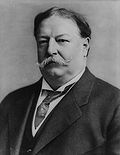 |
|
William Howard Taft |
4. ožujka 1909. |
4. ožujka 1913. |
Republikanska |
|
James S. Sherman[n 1]
4. ožujka 1909. – 30. listopada 1912. |
31 |
upražnjeno[n 2]
30. listopada 1912. – 4. ožujka 1913. |
| 28. |
 |
|
Woodrow Wilson |
4. ožujka 1913. |
4. ožujka 1921. |
Demokratska |
|
Thomas R. Marshall |
32 |
| 33 |
| 29. |
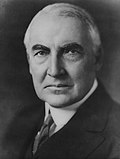 |
|
Warren G. Harding |
4. ožujka 1921. |
2. kolovoza 1923.
[n 1] |
Republikanska |
|
Calvin Coolidge |
34 |
| 30. |
 |
|
Calvin Coolidge |
2. kolovoza 1923. |
4. ožujka 1929. |
Republikanska |
upražnjeno[n 2] |
|
Charles G. Dawes |
35 |
| 31. |
 |
|
Herbert Hoover |
4. ožujka 1929. |
4. ožujka 1933. |
Republikanska |
|
Charles Curtis |
36 |
| 32. |
 |
|
Franklin D. Roosevelt |
4. ožujka 1933. |
12. travnja 1945.
[n 1] |
Demokratska |
|
John Nance Garner |
37
[n 9] |
| 38 |
|
Henry A. Wallace |
39 |
|
Harry S. Truman |
40 |
| 33. |
 |
|
Harry S. Truman |
12. travnja 1945. |
20. siječnja 1953. |
Demokratska |
upražnjeno[n 2] |
|
Alben W. Barkley |
41 |
| 34. |
 |
|
Dwight D. Eisenhower |
20. siječnja 1953. |
20. siječnja 1961.
[n 10] |
Republikanska |
|
Richard Nixon |
42 |
| 43 |
| 35. |
 |
|
John F. Kennedy |
20. siječnja 1961. |
22. studenog 1963.
[n 6] |
Demokratska |
|
Lyndon B. Johnson |
44 |
| 36. |
 |
|
Lyndon B. Johnson |
22. studenoga 1963. |
20. siječnja 1969. |
Demokratska |
upražnjeno[n 2] |
|
Hubert Humphrey |
45 |
| 37. |
 |
|
Richard Nixon |
20. siječnja 1969. |
9. kolovoza 1974.
[n 3] |
Republikanska |
|
Spiro Agnew[n 3]
20. siječnja 1969. – 10. listopada 1973. |
46 |
| 47 |
upražnjeno[n 2]
10. listopada 1973. – 6. prosinca 1973. |
|
Gerald Ford
6. prosinca 1973. – 9. kolovoza 1974. |
| 38. |
 |
|
Gerald Ford |
9. kolovoza 1974. |
20. siječnja 1977. |
Republikanska |
upražnjeno[n 2]
9. kolovoza 1974. – 19. prosinca 1974. |
|
Nelson Rockefeller
19. prosinca 1974. – 20. siječnja 1977. |
| 39. |
 |
|
Jimmy Carter |
20. siječnja 1977. |
20. siječnja 1981. |
Demokratska |
|
Walter Mondale |
48 |
| 40. |
 |
|
Ronald Reagan |
20. siječnja 1981. |
20. siječnja 1989. |
Republikanska |
|
George H. W. Bush |
49 |
| 50 |
| 41. |
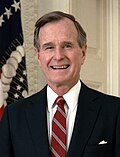 |
|
George H. W. Bush |
20. siječnja 1989. |
20. siječnja 1993. |
Republikanska |
|
Dan Quayle |
51 |
| 42. |
 |
|
Bill Clinton |
20. siječnja 1993. |
20. siječnja 2001. |
Demokratska |
|
Al Gore |
52 |
| 53 |
| 43. |
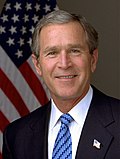 |
|
George Walker Bush |
20. siječnja 2001. |
20. siječnja 2009. |
Republikanska |
|
Dick Cheney |
54 |
| 55 |
| 44. |
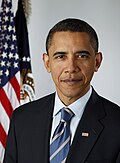 |
|
Barack Obama |
20. siječnja 2009. |
20. siječnja 2017. |
Demokratska |
|
Joe Biden |
56 |
| 57 |
| 45. |
 |
|
Donald Trump |
20. siječnja 2017. |
20. siječnja 2021. |
Republikanska |
|
Mike Pence |
58 |
| 46. |
 |
|
Joe Biden |
20. siječnja 2021. |
20. siječnja 2025. |
Demokratska |
|
Kamala Harris |
59 |
| 47. |
 |
|
Donald Trump
(drugi mandat) |
20. siječnja 2025. |
trenutno |
Republikanska |
|
J. D. Vance |
60 |
|













































